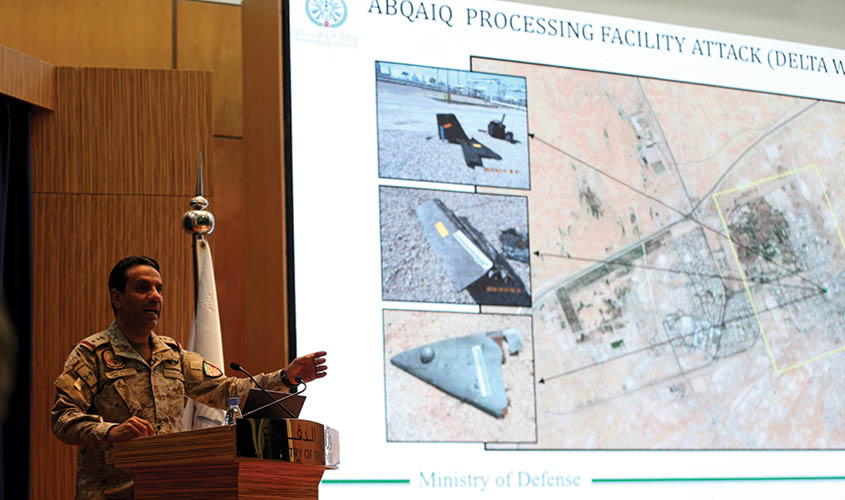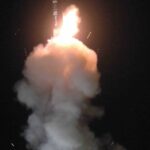
SOURCE: SUNDAY GUARDIAN LIVE
A Saudi defence ministry spokesman displays on a screen drones which Saudi government said attacked an Aramco facility, during a news conference in Riyadh on September 18, 2019.
While the Unmanned Combat Aerial Vehicles—UCAVs—are in the news for their use by the United States against terrorist targets, human and physical, mainly in West Asia, Iran, Afghanistan and Pakistan, as a “bolt from the blue”, the possibilities of other uses are endless: the drones are also being used as “Kamikaze” drones, or suicide drones, wherein loaded with explosives, a UAV crashes into a target, as was probably done in the attack on Saudi oil facilities.
If put to use for criminal and terrorist activities, such as spying on people and areas, smuggling drugs and weapons into prisons, as well as terrorist attacks on people, vehicles or buildings, the possibilities become endless; the ISIS has reportedly used drones in Iraq and Syria to descend vertically over tanks/vehicles and drop explosives or act as booby traps. Drones have become more powerful in recent years, with altitude, range, endurance, air speed and precision of navigation having improved appreciably, giving the drone the capability to carry more load.
The number of incidents of drones entering no-fly zones is on the rise; they have been sighted at airports—both in India and abroad—or large gatherings; until now such incidents have not caused any major harm, but drones can also be used for specific terrorist purposes. Consequently, security authorities are getting increasingly alarmed, as no effective defence system has been devised to date.
In 2014, a drone with a flag displaying Greater Albania was suddenly seen floating above the football field in Belgrade, during a European Football Championship qualifier between Albania and Serbia. With passions already running high, this triggered riots, resulting in the entire game being called off. What if the drone was carrying explosives, instead of the flag? Another instance occurred in broad daylight on August 4, 2018, in Venezuela, when President Nicolas Maduro, was apparently targeted with an off-the-shelf consumer drone. As early as in 2013, a small quadcopter flew within a few feet of German Chancellor Angela Merkel during a campaign rally, hovering briefly in front of the stage before crashing onto it. Even a small explosive charge or a grenade aboard the drone would have been catastrophic—and defending against such attacks is extremely difficult, to say the least.
The precision drone attack by the Houthi rebels of Yemen, targeting the economic heart of Saudi Arabia, on September 14, 2019, has finally given the proverbial “David” a weapon to measure up to his “Goliath” like opponents. The attack was a total surprise for the Saudi air defence, which, equipped with the latest of US-supplied radars and anti-ballistic missile defences, was caught totally unaware. It was carried out with precision, on targets more than 800 km away from their place of launch! As drones become smaller and quieter, they are easier to transport and launch, while being harder to detect and intercept, thus making them deadlier. Their relatively low cost and easy availability of material and components lower the technical threshold for their fabrication in a rough and ready environment. A tactical success by a relatively small player can deal a strategic blow with wider ramifications.
Immediately after the attack on Saudi oil installations, there have been two reported instances of drones flying across the International Border from Pakistan into Punjab; the first was in late September in the Amritsar area, wherein, eight sorties were flown under cover of darkness, over a period of 10 days, while the second intrusion was in the Hussainiwala sector in Ferozepur area. The drones were reported to be carrying arms, ammunition, satellite-phones and other equipment for initiating terrorist activities by sleeper cells in Punjab and J&K, of which some have been recovered.
In so far as the ramifications of the attack on Saudi oil facilities, India’s vulnerability is obvious. Apart from the security angle, it has economic issues too, as India is the world’s third-largest oil consumer, importing 83% of its oil needs; Saudi Arabia is India’s second largest supplier after Iraq. While Saudi Arabia assured India of meeting its requirements and got the oil terminals running within 10 days, India does not have enough reserves amongst the importing nations.
However, more worrisome for India are the drone-intrusions in Punjab from Pakistan, which has sleeper-cells on our side, to provide real-time information for any inimical activity. Media reports of September 29, 2019 have revealed that India has an estimated over 600,000 rogue or unregulated drones of various sizes and capacities and any one of these can be used for launching a terror act. Agencies are presently looking at specific anti-drone techniques to intercept and immobilise suspicious and probable lethal drones, which include tracking, jamming, kinetic and hybrid measures through hijacking and cyber approaches; such and other counter-drone measures are already in place in some countries. BSF has been given instructions to shoot down any suspicious drone below 1,000 feet, as anything above that height could be an aircraft and needs appropriate clearances for any action to be taken.
As drones become smaller and faster, new solutions will be required to disable them. It is important for anti-drone technology to be relatively future-proof, as drones will now be far smaller, maintain higher altitudes, and be equipped with advanced cameras with improved zooming systems. Smaller, lighter and more complex drones with multi-tasking ability are coming. We need an integrated national-level approach against the looming threat involving Ministry of Defence, Ministry of Home Affairs and the industry, in conjunction with the National Security Adviser and overseen by the Prime Minister’s Office. Security agencies, including the armed forces and the police forces have to join hands and work in tandem on a war footing.
Drones are a new security threat. India has to catch up with counter-drone technology. We cannot afford any laxity or delays in tackling this threat.
Air Marshal (Retd) Dhiraj Kukreja is an alumnus of National War College, United States, having the unique distinction of being the first IAF officer and only the fifth from the Indian Armed Forces, to have undergone a post-graduation course in “National Security Strategy”. Having held many important staff and field appointments, during his 40 years in the IAF, he retired as the AOC-in-C of Training Command. Post-retirement, he has been writing extensively on defence and diplomacy. He is a “Distinguished Fellow” with the Centre for Airpower Studies (CAPS) and a defence analyst.






